Traffic Analysis sounds like the “don’t try this at home” kind of endeavor. An operation only qualified professionals should be attempting, probably involving meticulous analysis of lots of numbers with complex formulas… well, yes and no.
“Yes” because there is meticulous analysis of lots of numbers with complex formulas – that’s why we use analytics tools. They take care of that.
“No” because once we understand we don’t have to do the complicated things, it’s really painting your data in a way that it becomes information. Data is boring and we don’t always understand it, information much more digestible and we can act on it.
The tool takes the boring part, we tackle the cool part. And the beautiful thing is that it doesn’t matter what tool we use. I’ll use Google Analytics to illustrate the samples below, but traffic analysis will start with the same basics regardless: trust, divide, and compare…
…and I think I just unexpectedly created a new acronym for basis of traffic analysis Trust, Divide and Compare: TRUDICO.
The one assumption we’re going to take here is that you know your business. You know why your operation existis – strengths and weaknesses, opportunities, etc.
1. Trusting Your Data
More often than not, the biggest hurdle for traffic analysis is our own data collection.
Many tools, including Google Analytics, pride themselves in their ease of installation. This is true, most tools out there are somewhat straightforward to install at a basic level. This claim however, has turned a few people to implement lazy installations. “Easy” is not the same as “just paste the tracking code”.
In order to really track what’s important and, equally as critical, ignore what’s not relevant, takes planning and work.
Many of our clients come with questions related to this step. They are collecting data, but something doesn’t look right.
Take a look at the following scenario:
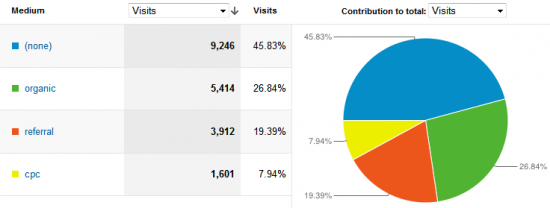
Imagine this is your account. It is collecting data for a new site and you know there’s a big push for paid traffic. The domain is new, so likelihood of organic traffic is low. Would these numbers make sense from a high-level perspective? Is this data reliable?
If you’ve worked with analytics before, you might already get the feeling that something looks strange. Why so many direct visits? and why so little paid traffic? After all, it is a new domain. Experience hints that we shouldn’t expect much direct or unpaid traffic if the only push we’re doing is for paid traffic. (It’s okay if you don’t see it, you will notice these trends with time.)
If you have these kind questions there’s probably something to it and you should follow up with your analyst or test yourself.
In this case AdWords Auto-Tagging was turned off so all paid traffic was not properly identified. What is AdWords Auto-Tagging? Here’s more information.
Trust your data. It’s step #1.
2. Divide Your Traffic Into Sensible Segments (or Buckets)
Depending on your business, you’ll be able to instinctively divide your website visitors into buckets or segments (I’ll call them segments). And good news: most tools already have some level of segmentation by default!
Most tools are able to divide traffic in 4 separate segments: Direct, Referral, Search and, Whatever You Want (campaign tagging). In Google Analytics, for example you have:

Tools help us, but rarely what the tool provide us is enough. More often than not, we need to take an extra step to make more sense out of things.
At the very least you should be doing two things:
a. Start thinking in Segments
When thinking about questions and answers related to traffic you should automatically thinking, “what segment are we talking about here?” A good place to start, if available, is to think about the personas used when the website was created.
For instance: “Did my Friday email blast work?” This is Email Traffic, but you should be able to isolate last Friday’s email. Or “Is my ‘sham-wowza’ paid campaign working?” This is paid traffic, but you should be able to to isolate the “sham-wowza” campaign.
Once you engage in this way of thinking, you’ll instinctively come up with good questions. Questions you can throw at your analytics team.
b. Tag Beyond the Basics
Your analytics tool likely allows you to give a bit more information to your traffic sources beyond what comes out of the box. That’s what “tagging” basically means, adding more information to a particular element.
This is good because not every industry is the same and not every business is dealing with the same scenarios.
- Paying for traffic? Make sure it’s identified as such to the keyword level.
- Sending Emails? Tag every link on your emails so it can be identified in your analytics.
- Have subscribers? Use advanced tagging (like Custom Variables) to segment these visitors.
Ultimately, you’re the best person to ask about the kind of segment you should have. Take a few moments, talk to your colleagues, and decide what kind of segments makes sense to configure.
3. Measure and Compare Against Goals and Time
This is the fun part. Measuring and comparing is when we get to say things like “The sham-wowza campaign had a Y% conversion rate increase when compared to last year!”
Why is comparing so critical? Because otherwise we don’t have a benchmark to base success. This may sound familiar because it’s a principle that applies to everything from analytics and finance, to hot dog eating contests and speed-showering.
Compare Against Goals
Defined Goals are as important as the measuring itself. Not having a goal is akin to not having a purpose. For instance, knowing that a certain percent of my traffic is downloading a whitepaper, signing up for a newsletter, or filling out a form is more important than knowing the total amount of visitors to my website.
Makes sense, right?
The only obvious caveat: you have decide what the Goals are. Who knows better what visitors should do your website other than you? A lot of the times this is more complicated than you think. It forces us to commit – and in my experience, everyone is afraid of commitment.
Once you have these goals, always compare traffic against them. Conversion rate and average visitor value is one of those metrics applicable across many industries.
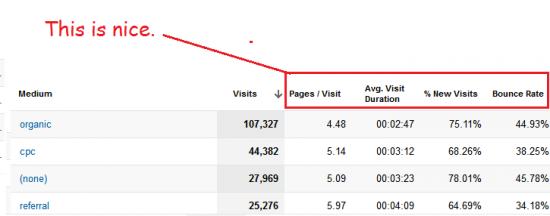
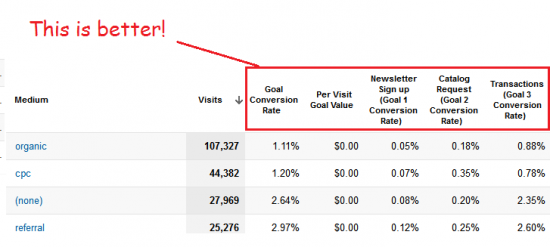
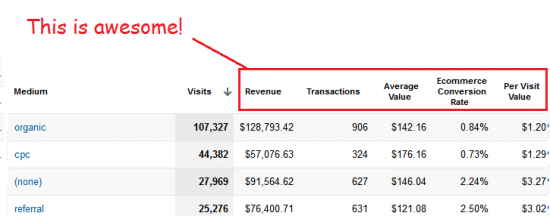
Compare Against Time
Time can be a benchmark. Imagine your analyst came to you with great news! Conversion rate for paid traffic 15%!!! OMG! OMG! OMG! That’s great!
But really, that means nothing.
In traffic analysis, numbers in isolation mean nothing. How much was the conversion rate last week? last month? last year? What if the conversion rate last month was 45%?
Time is your ally in understanding the success of your online efforts.
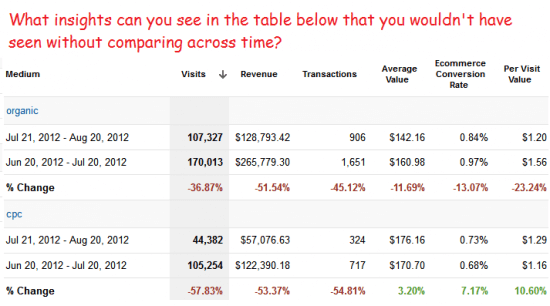
Share your thoughts in the comments.
Putting Everything Together
If you’ve read this far, you should be feeling a bit more comfortable with the idea of traffic analysis – one part data, nine parts common sense.
Trust, Divide and Compare. The next part is figuring out how to showcase the information or tell the story. Once you’re comfortable with the basics of TRUDICO it becomes time to learn about more advanced segmentation and, Key Performance Indicators (KPIs).
I think this post is long enough, so I won’t go into KPIs in any great detail. But in simple terms, KPIs are similar to goals in Google Analytics, but taken a step further. Often KPIs are straightforward metrics (Average Visit Duration) or calculated ratios (Conversion Rate) by taking on ore more metrics from your tool (like revenue) and combining them with other data points (like number of email signups in your database).
KPIs are going to help stay on track and make your analysis manageable. Otherwise you’ll be able to pick and choose the best metric for your reports. Face it, it’s another commitment.
Another seed that I want to plant in everyone’s minds is the holy grail of analysis: a dashboard.
A well done dashboard will be the one document-like place where everything is pre-done. Imagine a document with easy to understand graphs and charts that automatically updates with the most recent data, directly from your account, with the push of a button…
But let’s talk about that in a different post.
















